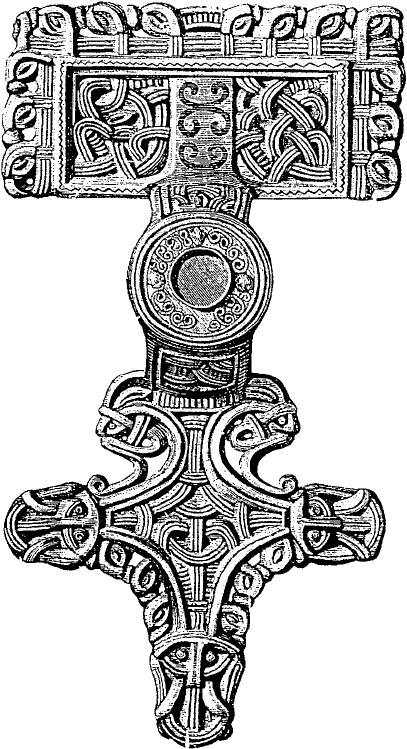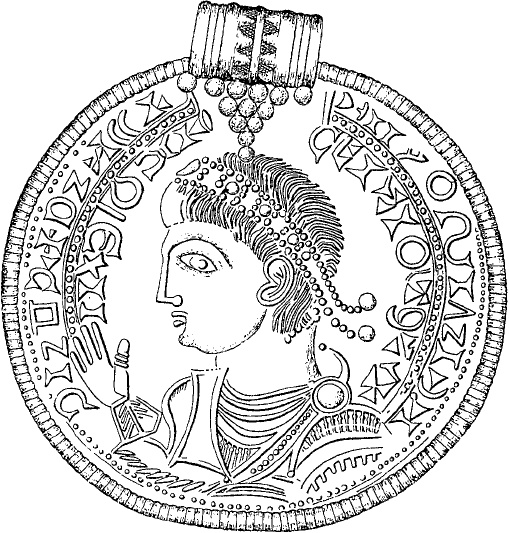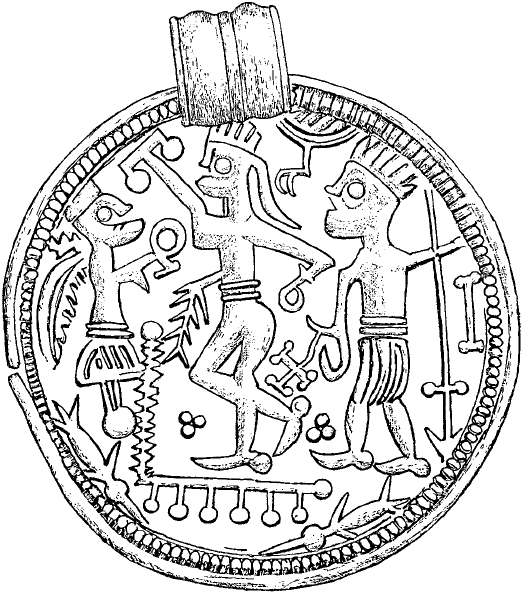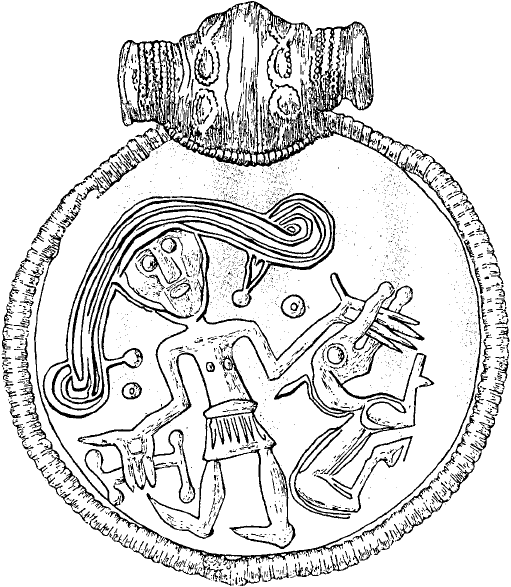Fouracre P. The New Cambridge Medieval History, Vol. 1: c. 500-c. 700
Подождите немного. Документ загружается.

Cambridge Histories Online © Cambridge University Press, 2008
Scandinavia 503
Both Cassiodorus and Jordanes thus allowed the Christian Ostrogoths and
their powerful kings in Italy to trace their descent from Scandinavia and a
pagan god; and this they did two centuries after this people had converted to
Christianity. In this, however, the Ostrogoths did not differ essentially from
other Germanic peoples such as, for instance, the Langobards in Italy in the
seventh century
20
or the Anglo-Saxons in England,
21
where Christian authors
legitimise their Christian people and Christian kings in a pagan prehistory.
The Scandinavian origin myth maintained by the Germanic peoples of early
medieval Europe was more than just a series of authors copying one another.
Myths played a vital role in the creation of a political mentality amongst the
new Germanic warlords and kings in Europe.
22
And this myth takes a special
turn when the example of the Heruli is taken into consideration.
The Heruli were one of the many Germanic peoples who are alleged to have
come from Scandinavia. Their own tribal history was never written – or at least
has not survived – so we know of them only from other sources. On the other
hand, this is one of the Germanic peoples whose fate is relatively well recorded
and whose connection with Scandinavia appears to be real. From as early as the
third century, after they had left their original homeland in Scandinavia, they
are referred to in written sources as auxiliary troops for the Romans both in
Europe and in Asia Minor, and on a raiding expedition through the Balkans,
along with the Goths amongst others, in 267.
Procopius, the Greco-Byzantine historian who lived c.490–555 ad and thus
was a contemporary of Jordanes, wrote profusely about the Heruli. After their
defeat by the Langobards in 512 they obtained the permission of the emperor
Justinian to settle in Illyria (in modern times the former Yugoslavia) although
many of them, in these circumstances, preferred to migrate northwards, back
to their original homeland. This led to a split, with one group remaining in
the Danube area while the other moved north. This migration is described in
some detail by Procopius (Wars vi.14, viii.36, xv.1–4). It is stated, for instance,
that ‘they reached the land of the Varnii [the Schleswig area], and then moved
rapidly through the land of the Danes to the sea and crossed over to Thule [the
Scandinavian peninsula], where they were received by the Gauts, who were
one of the largest groups there’.
Subsequently Procopius’ account traces how the southern group of Heruli
lacked a royal dynasty as the royal clan did not have many suitable members
(Wars vi.15, 27–33). A deputation was sent to the Scandinavian group to fetch
20
The history of the Langobards was first written down in 643 when they ruled Italy. The story of the
Langobards and King Rothari’s genealogy form part of the legal text Edictus Rothari written about
thirty years later. See further Gasparri (1983) and (2000).
21
According to Bede’s Ecclesiastical History of the English People (completed in 731), i.15.
22
Hedeager (1997), (1998) and (2000); Geary (2003); Hill (2003).
Cambridge Histories Online © Cambridge University Press, 2008
504 lotte hedeager
a suitable candidate. When, however, the chosen one died, the deputation
had to set off once again, and then came back with Datius and his personal
retinue of about 200 young warriors. In the meantime the southern Heruli had
given up waiting, and had asked the emperor Justinian to choose a king from
amongst themselves. Justinian selected Suartus, and when the deputation with
Datius and his retinue arrived from Scandinavia it caused yet another split as
some pledged loyalty to the one and some to the other of the two kings. When
Justinian gave his support to Datius, the Scandinavian king Suartus and his
supporters left Roman territory and became allies of the Gepids in Hungary.
23
The historical tradition concerning the Scandinavian origin of the Heruli
appears, in other words, to reflect a definite piece of historical reality. The
question naturally is whether the same can be the case with the many other
Germanic peoples who claimed descent from Scandza. Naturally, the factual
element within these early European migration myths is much disputed.
24
What is crucial, however, is not to what extent these people once emigrated
in small groups from Scandinavia, but that their royal identity was linked to
Scandinavia and that their kings were divine because they descended from
Gautr or Odin/Wotan, with this figure’s clear association with the German
pagan religion and, maybe, the Scandinavian pantheon.
The much later Old English epic poem Beowulf may well also draw on
traditions that have roots in the fifth and sixth centuries. Here there are possibly
ties between the ruling families of the Wylfingas, etymologically identical to
the Wuffingas, the East Anglian royal family, and the Wulfings who are thought
to have lived in what is now south-western Sweden and south-eastern Norway
during the late fifth and sixth centuries. Furthermore, there are archaeological
indications of kindred relations between the royal families of East Anglia and
Scandinavia in the sixth and seventh centuries, not least the connection revealed
between the Sutton Hoo ship burial and the ship burials from Vendel and
Valdg
¨
arde in the mid-Swedish M
¨
alar area.
25
scandinavian animal art
From the sparse written but rich archaeological material it is evident that
close contacts existed between the royal families of southern Scandinavia and
23
Heather (1998).
24
E.g. philologically and historically: Weibull (1958); Svennung (1967) and (1972); Wagner (1967);
Hachmann (1970); Goffart (1980) and (1988); Gasparri (1983) and (2000); Heather (1989), (1993),
(1994), (1995) and (1998); Wolfram (1990) and (1994); Pohl (1994); North (1997); Hedeager (2000);
Archaeologically: Hachmann (1970); Svennung (1972); Hines (1984), (1992), (1993), (1994) and
(1995); Menghin (1985); Busch (1988); N
¨
asman (1988); Heather and Matthews (1991) with refs.;
Kazanski (1991); Godlowski (1992); H
¨
arke (1992a) and (1992b); Hedeager (1992b), (1993), (1998) and
(2000); Christie (1995); Bierbrauer (1994).
25
Bruce-Mitford (1979); Lamm and Nordstr
¨
om (1983); Newton (1993), p. 117.
Cambridge Histories Online © Cambridge University Press, 2008
Scandinavia 505
those of the continent during the fifth, sixth and seventh centuries. The Scan-
dinavian origin myth among the Germanic royal families/peoples, expressed
in contemporaneous written sources, is supported by the archeological evi-
dence, notably weapons, jewellery and not least the iconography.
26
All over
Migration-period Europe, in Scandinavia, on the continent and in England,
anew iconographical style appeared in the middle of the fifth century. The
development of the earliest animal style was closely connected with south-
ern Scandinavia.
27
Aremarkably rich variety of figurative and geometric fig-
ures, often with human features (masks) as part of the whole,
28
developed
in this area during the first half of the fifth century, known as the Nydam
style and Style i
29
(see Fig. 1). Finds on the continent and in England are
well represented from the latter half of the fifth century up to the end of the
sixth,
30
when a new style, Style ii, emerges, homogeneous from Italy to the
Nordic countries.
31
Style ii is, like the first one, remarkably uniform, and both
styles are found on jewellery and weapons from most parts of Europe
32
(see
Fig. 2).
From about the beginning of the fifth century up until the seventh, the
Nordic figurative world was used as a symbolically significant style amongst
the migrating Germanic peoples. It was imitated and elaborated, becoming an
impressive elite art style.
33
Style ii continued into the late seventh century, and
from then on it is no longer possible to define a common Germanic animal
style. Once Catholic Christianity had put down firm roots a new iconographic
style developed: one that blended insular with Frankish elements, and was
closely connected to the Irish/Anglo-Saxon mission which began in Friesland
in 678/9 and reached central and south Germany during the first half of the
eighth century.
34
While this style was so indisputably linked with missionary activity, and
can be found on a lengthy series of different ecclesiastical objects, it is not
restricted to ‘church art’ alone. A wide variety of secular objects of precisely
the same kind as earlier were now decorated with this new Christian style:
dress accessories, riding equipment, stirrups, spurs, bracelets and so on, thus
signalled a new form of ideological legitimisation for their owners. Southern
Scandinavia, in particular, was not uninfluenced by the ideological attachment
to Latin Christianity of the European warrior elite and their powerful rulers.
Though Nordic animal style continued independently, with the disintegrated
animal figures being to some extent recreated to recover their zoomorphic
26
Hedeager (1998).
27
Roth (1979); Haseloff (1981) and (1984).
28
Haseloff (1986).
29
Salin (1904).
30
Roth (1979); Haseloff (1981); Hines (1984); N
¨
asman (1984), map 10 and (1991), fig. 8.
31
Salin (1904); see also Lund Hansen (1992), p. 187 with literature.
32
Karlsson (1983).
33
Speake (1980); Høilund Nielsen (1997).
34
Roth (1979), p. 86.

Cambridge Histories Online © Cambridge University Press, 2008
506 lotte hedeager
Figure 1.Silver brooch with early animal style from Sealand, Denmark
(after Åberg (1925), fig. 161)
character, the new style from the eighth century onwards absorbed some insular
elements, such as decorative plant motifs, but this was only briefly.
35
In Scandinavia, where a pagan warrior elite and a fragmented state structure
persisted during the Viking Age, pagan myths and iconographic symbols –
the animal style – therefore continued to play an organising role in the cos-
mology of this warrior society up to the end of this period. Although still in
35
Karlsson (1983); Hedeager (1999a).

Cambridge Histories Online © Cambridge University Press, 2008
Scandinavia 507
Figure 2.Silver brooch with style ii from Hordaland, Norway
(after Åberg (1925), fig. 169)
use, the Nordic animal style ceased to develop from around 1100.
36
On this
premise, elements of style, not least iconographic ones, are presumed to have
36
It did not survive the meeting with a new belief system and the political and social implications that
this entailed. This can of course be explained through the idea that people – especially the elite –
had acquired different tastes and therefore preferred a new style around 1200 under the influence of
the church. More convincingly, however, it can be argued that the lack of potential for survival and
renewal of the animal styles in a Christian context had to do with its anchoring in a quite different
system of belief (Hedeager (2003)).
Cambridge Histories Online © Cambridge University Press, 2008
508 lotte hedeager
been selected with a great deal of care, just as objects are very carefully selected
for use in ceremonies because they are embedded with special qualities and
are the bearers of important messages, communicating, for example, social
relationships, group membership and ethnic identity.
37
Style, then, must also
be seen as involved in the creation and maintenance of the socio-cosmological
order and as such participates in the legitimisation of power. Upholding style
can be regarded as a part of the elite’s strategy in the same way as the mainte-
nance of ritual functions, myths, legends and symbolic objects – in short, all
that embodies the group’s identity. Seen in this light, Germanic animal styles
acquire a new, more significant function.
Even though there can therefore be little doubt about the signifying function
of animal ornament or its elite character, this does not explain what the animals
symbolise or why it was animal ornament in particular which took on such
great importance. However, the role of animal style as an inseparable part of the
pre-Christian material culture implies that the animals also had an indisputably
significant position in the pre-Christian perception of the world.
38
If this is
the case then it might just be possible to come closer to some central, cognitive
structures in sixth- and seventh-century Scandinavia by focussing on these
animals and the iconographic depictions as such.
central cognitive structures in scandinavian societies
It is hardly surprising that the perception of the Scandinavian world underwent
changes during a period of 800 years, from the fourth to the eleventh century.
That the animal ornamentation did the same thing is a logical consequence.
Butinspite of any stylistic variations and new elements, there is one funda-
mental element that connects all the styles together, namely the animal.From
being a simple classificatory element, suitable for chronological and stylistic
classifications in traditional cultural-historical archaeology, the enquiry shifts
from investigating animal representation in this art and becomes a topic with
complex implications for cognitive archaeology. Representation is always more
than a matter of whether the animal’s naturalistic form is reproduced, and ani-
mal representation cannot only be explained in terms of artistic expression.
Representation operates within a particular set of cultural codes, and the ani-
mal representations therefore become part of the cognitive structures. And as
such, the styles are not just ‘art for art’s sake’, but also must be seen as a form of
37
Earle (1990), p. 73;DeMarrais, Castillo and Earle (1996).
38
Kristoffersen (1995) and (2000b); Glosecki (1989); Hedeager (1997), (1998), (2003) and (2004);
Gaimster (1998); Andr
´
en (2000); Lindstrøm and Kristoffersen (2001); Magnus (2001); Jakobsson
(2003).
Cambridge Histories Online © Cambridge University Press, 2008
Scandinavia 509
cultural knowledge, settled into the constitutional context of society. Animal
representations must then be an expression for the way animals were perceived
and the significance they were given.
39
The Nordic animal ornamentation does not merely incorporate animals, it
is animals, that is to say, it is entirely a paraphrasing of a many-faceted complex
of animal motifs. Whole and half animals, small and large animals, animal
fragments and anatomically complete animals, along with animal heads with-
out bodies and animal bodies without heads. This complex representation,
far removed from naturalistic animal depictions, reveals that the styles do not
attempt to mirror the animals themselves. Complex composed animals may
express a reality that is more precise, more revealing and more ambiguous,
than the naturalistic representation ever could. Here species are created that
cut across all categories by transgressing the boundaries of what is considered
‘natural’.
40
This ambiguity, where a figure on closer inspection is shown to rep-
resent something else entirely, reflects hidden meaning, where one level, so to
say, hides the other and makes the styles more powerful than otherwise would
be possible to achieve through the written or spoken word. Their complex-
ity suggests that these styles, structurally speaking, incorporate an overriding
abstract principle, reflecting social order and – perhaps subconsciously – also
the physical order of the universe.
41
Another characteristic of mainly the sixth- and seventh-century styles is
the representation of animal heads inside each other, as part of each other,
and to this complexity human representations are attached. Human bodies are
also reproduced cut into pieces, and human faces (‘masks’) are included in the
animal representations,e.g. bodies with human heads and human faces as part –
normally the thigh – of the animal or the bird. Thus, the renderings cross not
only the boundaries between various animal species but also the boundaries
between animals and humans.
It can be argued that the animal styles – consciously or unconsciously –
reflect cognitive structures in sixth- and seventh-century pre-Christian soci-
eties. Even when the structural levels in the styles include abstract and often
unconscious principles that reflect social and universal order, they are hardly a
conscious representation of the myth. The mythical level, on the other hand,
is represented through the obvious visual message, with the iconography and
oral rendering referring to the same ‘story’. This level can, however, be reflected
in the naturalistic and therefore immediately more accessible iconographic art
from these centuries. Two examples are to be mentioned.
39
Morphy (1989), p. 2.
40
Morphy(1989), p.5;Ingold ( 2000), p.130; Kristoffersen (2000b), p.265; Lindstrøm and Kristoffersen
(2001); Jakobsson (2003); Hedeager (2004).
41
Roe (1995), p. 58.

Cambridge Histories Online © Cambridge University Press, 2008
510 lotte hedeager
Figure 3.Gold bracteate from Lilla Jored, Sweden (after Hauck (1985–89),
no. 107)
First, special attention may be paid to the gold bracteates. Although their
motifs and designs are unmistakably Nordic, the bracteates have their origin
in late antique art and Byzantine emperors’ medallions
42
(see Fig. 3). Several
of the depicted scenes appear to be an illustration of central myths in Nordic
mythology,
43
for example Balder’s death
44
(see Fig. 4) and Tyr, who, in order
to save the world, offered his right hand in the mouth of the Fenris wolf
(Snorra Edda, chs. 24 and 33)
45
(see Fig. 5). Both appear to belong to the
central myths of the fifth and sixth centuries.
46
The majority of the bracteates,
however, reflect what has been interpreted as Odin at the height of his power,
i.e. on his journey to the Other World in disguise as a bird (see Fig. 6). A
large animal, a hybrid between a horse, a moose and a goat, escorts him.
From its mouth it is not uncommon to see the sign of a breath. That is to
42
Hauck (1985–89).
43
Hauck (1986).
44
Ellmers (1970), p. 210;Hauck (1978), p. 210 and (1994).
45
Oxenstierna (1956), p. 36;Ellmers (1970), pp. 202, 220;Hauck (1978), p. 210.
46
Hedeager (1997).

Cambridge Histories Online © Cambridge University Press, 2008
Scandinavia 511
Figure 4.Gold bracteate from Fakse, Denmark (after Hauck (1985–89), no. 51)
say, the animal is animate. Birds and snakes often follow on the journey. The
shape-shifting (‘shamanistic’)
47
element in this rendering seems convincing: a
‘human’ in bird disguise and animal followers (the snake, the bird and the big
four-legged animal) are fundamental components in the iconographic universe
of the bracteates.
48
That the origin of the bracteates stems from the late Roman
emperors’ medallions only confirms the strong symbolic importance which
resides in comparing the Roman emperors to the Asir kings.
49
Everywhere in
the Old Norse texts Odin appears in the guise of others; he crosses the boundary
between human and animal, between male and female. He is in control of the
specific magical power called sei
∂r, i.e. shape-shifting, and this specific skill is
what makes him king of the Asir.
50
47
Price (2002) has examined the ritual practices of the north in relation to the ‘shamanistic’ culture of
the S
´
ami people with whom they shared much of the Scandinavian peninsula.
48
Hedeager (1997), (2003) and (2004).
49
Axboe (1991); Andr
´
en (1991).
50
E.g. Hedeager (1999a); Price (2002); Solli (2002). The indisputable nexus between sei∂r, ecstasy
and soul-journey is identical to the religious complex known as ‘shamanism’: Str
¨
omb
¨
ack (1935),

Cambridge Histories Online © Cambridge University Press, 2008
512 lotte hedeager
Figure 5.Gold bracteate from Trollh
¨
attan, Sweden (after Hauck (1985–89), no. 190)
Second, from the Migration period to the Viking Age depictions of humans
in animal form can be found, primarily attached to the rich warrior equipment
from the sixth and seventh centuries, e.g. Vendel and Valsg
¨
arde in the mid-
Swedish M
¨
alar area and Sutton Hoo in East Anglia. Most commonly portrayed
is the so-called wolf warrior,
51
but the warrior in a wild boar skin or disguise
can also be found.
52
And the helmets have a complete animal symbolism
in themselves, with either a boar or an eagle on the crest, or as part of the
helmet’s composition.
53
These splendid helmets consist then of three animals,
(1970); Ohlmarks (1939); Brøgger (1951); Buchholz (1971); Ellis Davidson (1988); Eliade (1989), etc.;
cf. also Polom
´
e(1992), who argues against such an interpretation. See the comprehensive studies
by Karl Hauck, where the motifs on the A- and C-bracteates (Mackeprang (1952)) have been inter-
preted as representing one and the same person, most probably Odin (Hauck (1974); for an exten-
sive bibliography see Hauck (1985–89)). Odin is depicted as magician and shaman (Hauck (1978),
p. 211).
51
Høilund Nielsen (1999), p. 332.
52
Hedeager (2004), fig. 16.
53
Bruce-Mitford (1979), p. 35;Glosecki (1989); Hedeager (2004), fig. 22.
